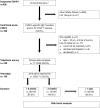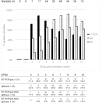Chikungunya virus infection in Aruba: Diagnosis, clinical features and predictors of post-chikungunya chronic polyarthralgia
- PMID: 29709007
- PMCID: PMC5927412
- DOI: 10.1371/journal.pone.0196630
Chikungunya virus infection in Aruba: Diagnosis, clinical features and predictors of post-chikungunya chronic polyarthralgia
Abstract
Background: Chikungunya virus (CHIKV) emerged in Aruba for the first time in 2014. We studied the clinical presentation of acute CHIKV infection and the contribution of serologic and molecular assays to its diagnosis. In a cohort of confirmed CHIKV cases, we analysed the frequency, duration and predictors of post-chikungunya chronic polyarthralgia (pCHIK-CPA), defined as joint pains lasting longer than 6 weeks or longer than 1 year.
Methodology: Patient sera obtained within 10 days of symptom onset were tested for CHIKV, using an indirect immunofluorescence test for the detection of CHIKV-specific Immunoglobulin M (IgM) and post-hoc, by reverse-transcription polymerase chain reaction (RT-PCR). CHIKV was isolated from selected samples and genotyped. For confirmed CHIKV cases, clinical data from chart review were complemented by a Telephone survey, conducted 18-24 months after diagnosis. When joint pain was reported, the duration, presence of inflammatory signs, type and number of joints affected, were recorded. Joint involvement was scored according to the 2010 'American College of Rheumatology/ European League Against Rheumatism' criteria for seronegative rheumatoid arthritis (ACR-score). Risk factors for pCHIK-CPA were identified by logistic regression.
Principal findings: Acute CHIKV infection was diagnosed in 269 of 498 sera, by detection of IgM (n = 105), by RT-PCR (n = 59), or by both methods (n = 105). Asian genotype was confirmed in 7 samples. Clinical data were complete for 171 of 248 (69.0%) patients, aged 15 years or older (median 49.4 [35.0-59.6]). The female-to-male ratio was 2.2. The main acute symptoms were arthralgia (94%), fever (85%), myalgia (85%), headache (73%) and rash (63%). In patients with arthralgia (n = 160), pCHIK-CPA longer than 6 weeks was reported by 44% and longer than 1 year by 26% of cases. Inflammatory signs, stiffness, edema and redness were frequent (71%, 39% and 21%, respectively). Joints involved were knees (66%), ankles (50%), fingers (52%), feet (46%), shoulders (36%), elbows (34%), wrists (35%), hips (31%), toes (28.1%) and spine (28.1%). Independent predictors of pCHIK-CPA longer than 1 year were female gender (OR 5.9, 95%-CI [2.1-19.6]); high ACR-score (7.4, [2.7-23.3]), and detection of CHIKV-RNA in serum beyond 7 days of symptom onset (6.4, [1.4-34.1].
Conclusions: We identified 269 CHIKV patients after the first outbreak of Asian genotype CHIKV in Aruba in 2014-2015. RT-PCR yielded 59 (28%) additional CHIKV diagnoses compared to IgM antibody detection alone. Arthralgia, fever and skin rash were the dominant acute phase symptoms. pCHIK-CPA longer than 1 year affected 26% of cases and was predicted by female gender, high ACR-score and CHIKV-RNA detection beyond 7 days of symptom onset.
Conflict of interest statement
Figures



References
-
- Robinson MC. An epidemic of virus disease in Southern Province, Tanganyika Territory, in 1952–53. I. Clinical features. Trans R Soc Trop Med Hyg. 1955;49: 28–32. doi: 10.1016/0035-9203(55)90080-8 - DOI - PubMed
-
- Ross RW. The Newala epidemic. III. The virus: isolation, pathogenic properties and relationship to the epidemic. J Hyg (Lond). 1956;54: 177–91. doi: 10.1017/S0022172400044442 - DOI - PMC - PubMed
-
- Lumsden WHR. An epidemic of virus disease in Southern Province, Tanganyika Territory, in 1952–53. II. General description and epidemiology. Trans R Soc Trop Med Hyg. 1955;49: 33–57. Available: http://www.ncbi.nlm.nih.gov/pubmed/14373835 - PubMed
-
- Zeller H, Van Bortel W, Sudre B. Chikungunya: Its History in Africa and Asia and Its Spread to New Regions in 2013–2014. J Infect Dis. 2016;214: S436–S440. doi: 10.1093/infdis/jiw391 - DOI - PubMed
-
- Charrel RN, Leparc-Goffart I, Gallian P, de Lamballerie X. Globalization of Chikungunya: 10 years to invade the world. Clin Microbiol Infect. 2014;20: 662–663. doi: 10.1111/1469-0691.12694 - DOI - PMC - PubMed
Publication types
MeSH terms
Substances
LinkOut - more resources
Full Text Sources
Other Literature Sources
Medical

